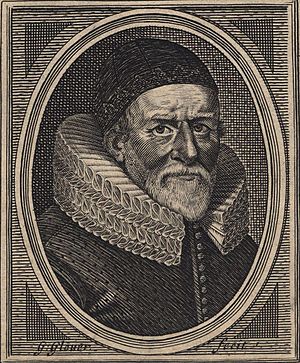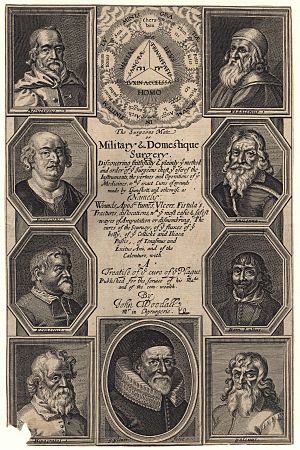John Woodall facts for kids
John Woodall (1570–1643) was an English surgeon, chemist, and businessman. He also spoke several languages and worked as a diplomat. He became very wealthy by preparing medical supplies for the East India Company. Later, he did the same for England's armed forces. He wrote an important book called The Surgeon's Mate. This book was a guide for surgeons on ships about how to treat illnesses at sea. In his book, he suggested certain foods that could have stopped a terrible disease called scurvy.
Contents
John Woodall's Early Life and Career
John Woodall was born in Warwick. When he was about 16 or 17, he started learning to be a barber-surgeon in London. He didn't finish his training there. Instead, at age 19 in 1589, he joined Lord Willoughby's army as a surgeon. They went to help Henry IV of France fight against the Catholic League in France. He came back to England in 1590.
Woodall then lived and worked as a surgeon in Poland and in Stade, a port city near Hamburg in Germany. While he was there, English ambassadors sometimes hired him to translate German.
In 1599, he became a full member of the Barber-Surgeons Company of London. But he mostly lived in Holland until 1603. Then he moved to London. He helped people who were sick during the bubonic plague outbreak. Woodall himself caught the plague twice and survived. He wrote about it, saying he had it "twice... in my Groyne."
Working for the East India Company
In 1604, James I of England sent a group of people to Poland and Russia. Sir Thomas Smith, who was in charge of the East India Company, led this group. Woodall joined them because he knew the area and spoke the languages. This connection with Sir Thomas Smith was very good for Woodall.
In 1612, Sir Thomas made Woodall the main surgeon for the East India Company. His job was to make sure all ships had good surgeons and plenty of medical supplies. He also had to treat anyone hurt while working for the company.
Woodall's career grew quickly. In 1616, he became a surgeon at St. Bartholomew's Hospital. There, he worked with a famous doctor named Sir William Harvey. Woodall was promoted within the Barber-Surgeons Company. He became an examiner in 1626, a warden in 1627, and finally the master in 1633.
Challenges and Later Career
In 1625, Woodall faced a problem. He tried to get money from Sir Thomas Merry, who worked for the King. Because he tried to collect money from a royal servant, Woodall was put in prison. He was let out briefly to prepare medical supplies for the next fleet of ships, but then he was jailed again. He was only set free after saying he was sorry.
In 1626, the King's advisors decided to pay the Barber-Surgeons Company to provide medical supplies for the army and navy. Woodall was put in charge of this plan. This was in addition to his long-standing job with the East India Company.
The East India Company eventually let him go in 1635 because of money issues. However, he still had the only right to supply medical chests to the company. He kept this right until he died in 1643, at 73 years old.
The Surgeon's Mate and Scurvy Prevention
John Woodall's most famous book, The Surgeon's Mate, was first published in 1617. Later versions of the book included sections on:
- How to treat wounds made by gunshots.
- How to deal with the very scary and contagious disease called the plague.
- A guide to treating gangrene, especially about removing a body part that has died.
A very important part of the book (pages 160–176) was about scurvy. Scurvy was a terrible disease that often affected sailors on long voyages. It caused weakness, bleeding gums, and eventually death.
Woodall wrote that many good remedies were known in England for scurvy, like scurvy-grass and horseradish. He said these helped people at home. He also noted that fresh air and a better diet could help sailors who returned from long trips. But for sailors at sea, he said that "Lemmons, Limes, Tamarinds, Oranges, and other choice of good helps in the Indies... do farre exceed any that can be carried tither from England." This showed that he understood that citrus fruits were the best way to prevent scurvy, long before it was widely accepted.



